


xxxxxAs we have seen, for much of 1864 the Confederates were on the defensive. General Grant’s “Overland Campaign” pinned down the Southerners in Virginia, whilst in the West, Tennessee was captured and General Sherman, after taking Atlanta in the September, was able to march through Georgia and occupy Savannah by the end of the year. 1865 saw the fall of Petersburg and Richmond and the advance of Sherman through South and North Carolina. By April 1865 General Lee was forced to surrender to Grant at the small village of Appomattox Court House. Throughout the conflict the Confederates had fought well, and had gained the advantage in the opening campaigns in the East. By late 1863, however, the decided advantages held by the North in manpower, transport, and the production of munitions began to tell. The Southern states, predominantly agricultural, depended on the import of war material through ports which were often blockaded by Union ships. Furthermore, the failure of the South to gain support from Europe, notably Britain and France, and the increase in Union manpower which followed the Proclamation of Emancipation in January 1863 -
THE END OF THE AMERICAN CIVIL WAR
THE CONFEDERATE SURRENDER -
Acknowledgements
Surrender: detail, by the French portrait painter Louis Guilaume (1816-
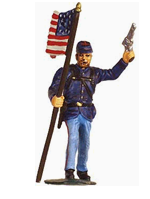
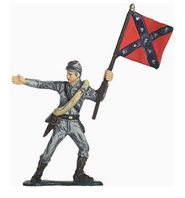 xxxxxAs we have seen, the Union’s crushing victory at Gettysburg, Pennsylvania, in July 1863, together with its triumph at Vicksburg, Mississippi, one day later, proved something of a watershed in the conduct of the civil war. The first repulsed Lee’s invasion of the North, and the second split the Confederacy in two and gave the Unionists control of the Mississippi River. There were to be a large number of well-
xxxxxAs we have seen, the Union’s crushing victory at Gettysburg, Pennsylvania, in July 1863, together with its triumph at Vicksburg, Mississippi, one day later, proved something of a watershed in the conduct of the civil war. The first repulsed Lee’s invasion of the North, and the second split the Confederacy in two and gave the Unionists control of the Mississippi River. There were to be a large number of well-
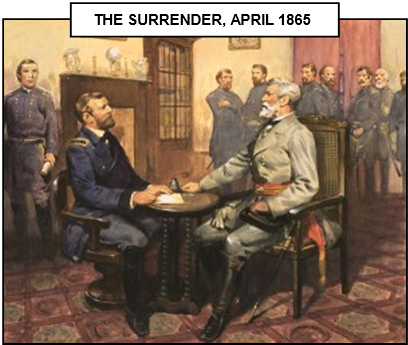
xxxxxIn the New Year Sherman turned north and advanced through South and North Carolina. With the capture of Wilmington in North Carolina in January 1865 -
xxxxxIncidentally, as a sign of respect towards his enemy, and a gesture towards reconciliation, Grant allowed Confederate officers to keep their side arms along with their private horses and personal baggage. Thus Lee was not required to offer up his personal sabre as a sign of surrender, and he retained his famous horse Traveller. ……
xxxxx…… The McLean House where the surrender was signed was re-

xxxxx…… Jefferson Davis the first and only President of the Confederate States of America, was captured in May 1865 and imprisoned until 1867 on a charge of treason. In 1868, however, the Federal government dropped the case against him. He made a number of visits to Europe, served for some years as president of a Memphis insurance firm, and during his retirement wrote The Rise and Fall of Confederate Government, published in 1881. ……
xxxxx…… InxthexCivil War the term Yank (or Yankee) was used by Southerners as a term of contempt for Union soldiers or Northerners in general. The name previously referred to natives of New England (probably from the Dutch word Janke, a diminutive of Jan) and became a popular term in the American War of Independence -
xxxxx…… Andxworthy of mention is Harriet Tubman (c1820-
xxxxx…… Duringxthe war a number of warships employed by the Confederate States as commerce raiders -
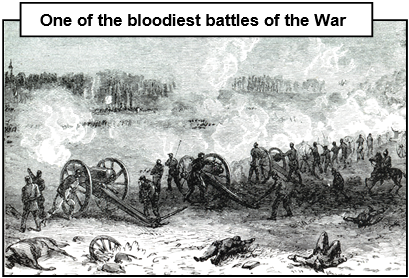
xxxxxThe major reasons for the success of the Union are not difficult to determine. The Confederate armies acquitted themselves well for much of the war, and were especially successful in the opening campaigns in the East, but from the beginning of the conflict the Unionists had a number of decided advantages, and these weighed heavily in their favour as the war dragged on and became wider in scope and more costly in manpower and munitions. Its numerical strength was about four times greater than that of the South and this was a major factor in a war which developed into one of attrition. Inxthexlast year especially, Lee’s army was being constantly thinned by desertion as well as by the losses inflicted by General Ulysses Grant in his Virginian “Overland Campaign” -
xxxxxFurthermore, Lincoln’s Emancipation Proclamation of September 1862, enacted in January 1863, virtually put an end to the Confederacy’s chances of receiving aid from Britain or France, despite their dependence on the import of raw cotton. This was a source of assistance which might well have swung the balance in favour of the South’s bid for independence. In addition, the proclamation enabled close on 200,000 free blacks and escaped slaves to swell the ranks of the Union army in the closing years of the war.
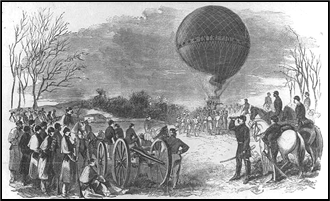
xxxxxThe American Civil War demonstrated a number of technological advances on the battlefield. The use of observation balloons, for example, employed by the French as early as the Battle of Fleurus in 1794, was further developed. Tethered to the ground or free flying, balloons were used for reconnaissance purposes and, on occasions, to direct artillery fire onto enemy positions (illustrated). The Union army had its own balloon corps and this provided useful information to ground forces, particularly at the Battle of Fair Oaks in 1862 and during the build-
Including:
The Reconstruction

xxxxxAfter the end of the Civil War in 1865 the Reconstruction of the Union proved a long and difficult task. Whilst the North emerged almost intact, much of the South had been laid to waste and its economy, based on slavery, had been virtually ruined. Both Lincoln and, after his assassination, Andrew Jackson, were anxious to provide generous terms in order to heal the nation’s wounds, but in 1866 the radicals gained control of Congress and imposed a military occupation of the South. By 1870 all the Southern states had gained readmission to the Union, but the last Federal troops did not leave until 1877. This military occupation added to the South’s humiliation, and only served to increase the hatred and bitterness which had been engendered on both sides during a long and bloody conflict. And whilst the Civil War gave freedom to some 4 million black people, this had little real effect in many parts of the Deep South. With the end of Reconstruction in 1877 ultra-
xxxxxAfter such a long and bloody war, the Reconstruction of the Union was only achieved after decades of political and social rancour. At the personal level, the hatred and bitterness it engendered remained causes of division well into the 20th century, and some of the scars have yet to heal. Such is hardly surprising. The conflict had cost close on a million casualties, including 620,000 dead, and whilst the North emerged with its industrial power intact, much of the South had been laid to waste and its economy, based on slavery, had been virtually ruined. Farmsteads and barns had been burned down, railroads torn up, and bridges destroyed, and many cities, such as Richmond, Atlanta and Vicksburg, had been badly damaged. The Union victory reunited the country politically, but economically and socially the United States remained a divided nation for many years to come.
xxxxxLincoln’s Proclamation of Amnesty and Reconstruction was issued in December 1863. In keeping with his desire “to bind up the nation’s wounds”, it was a lenient settlement aimed at bringing the break-
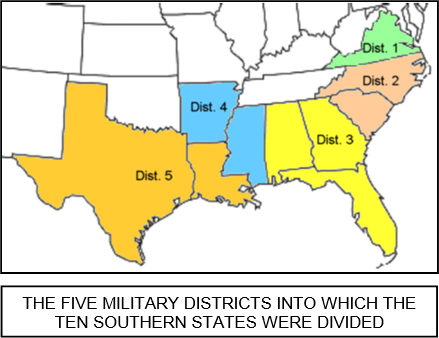 xxxxxWith Lincoln’s assassination just a few days after the end of the war, the question as to whether he could have persuaded the radicals in Congress to accept this Proclamation has to remain unanswered, though it would seem most unlikely. His successor, Andrew Jackson, did continue his policy of reconciliation. In May 1865 he issued a formal pardon in respect of all Southern states, and he saw through the 13th Amendment to the Constitution, forbidding slavery throughout the United States. However, the radicals triumphed in the elections of 1866, and this resulted in a military occupation of all Southern states except Tennessee. By 1870 all these states had been readmitted to the Union following their acceptance of universal male suffrage and the 14th Amendment (providing all persons equal protection under the law), but the last Federal troops remained in the South until 1877. Needless to say, this military occupation (close to martial law at times) was offensive and humiliating to the Southerners, and only served to increase the enmity between the former enemies.
xxxxxWith Lincoln’s assassination just a few days after the end of the war, the question as to whether he could have persuaded the radicals in Congress to accept this Proclamation has to remain unanswered, though it would seem most unlikely. His successor, Andrew Jackson, did continue his policy of reconciliation. In May 1865 he issued a formal pardon in respect of all Southern states, and he saw through the 13th Amendment to the Constitution, forbidding slavery throughout the United States. However, the radicals triumphed in the elections of 1866, and this resulted in a military occupation of all Southern states except Tennessee. By 1870 all these states had been readmitted to the Union following their acceptance of universal male suffrage and the 14th Amendment (providing all persons equal protection under the law), but the last Federal troops remained in the South until 1877. Needless to say, this military occupation (close to martial law at times) was offensive and humiliating to the Southerners, and only served to increase the enmity between the former enemies.
xxxxxAs far as the abolition of slavery was concerned, the civil war gave freedom to some four million black people but, in reality, this was only a paper exercise in many areas south of the Mason-
 xxxxxIncidentally, during the period of Reconstruction quite a large number of Northerners moved to the South. Many were well-
xxxxxIncidentally, during the period of Reconstruction quite a large number of Northerners moved to the South. Many were well-
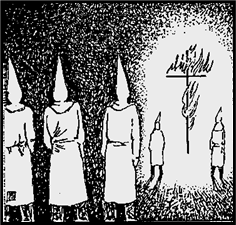 xxxxx…… Bothxthe carpetbaggers and the scalawags became targets of the Ku-
xxxxx…… Bothxthe carpetbaggers and the scalawags became targets of the Ku-
Vb-


